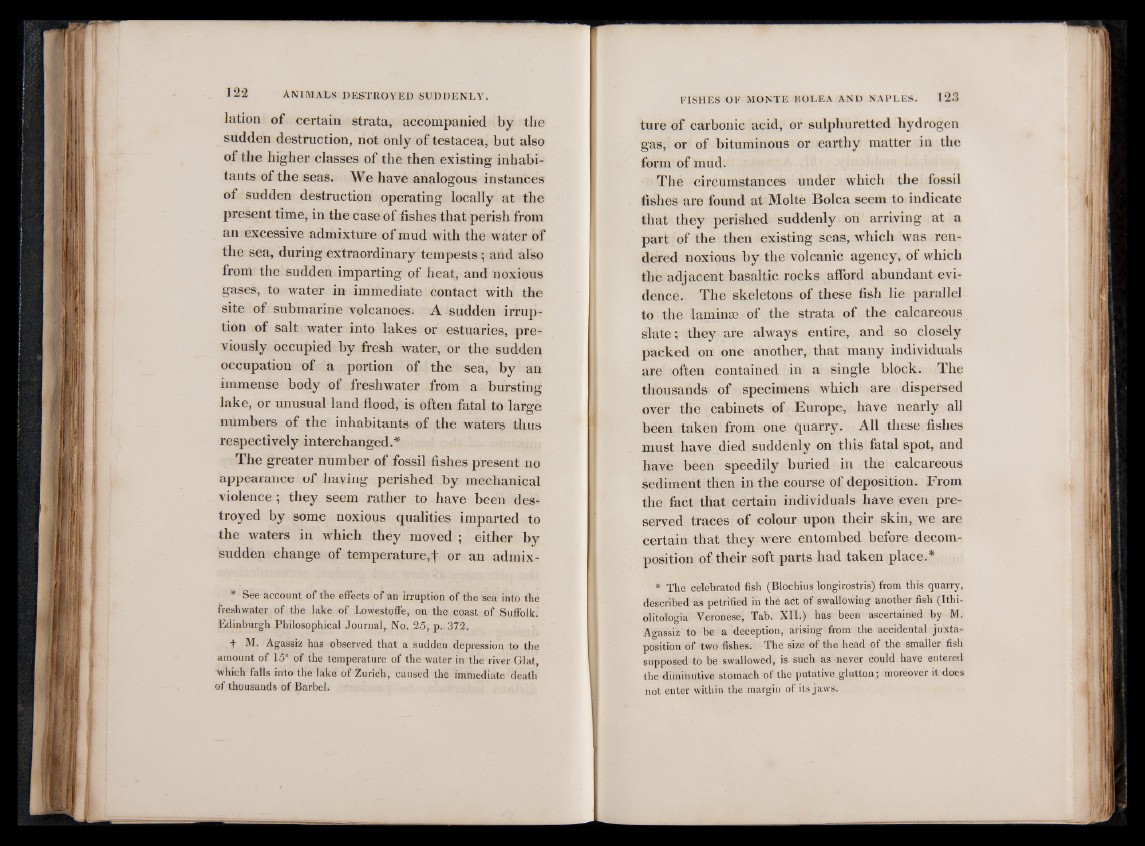
lation of certain strata, accompanied by the
sudden destruction, not only of testacea, but also
of the higher classes of the then existing inhabitants
of the seas. We have analogous instances
of sudden destruction operating locally at the
present time, in the case of fishes that perish from
an excessive admixture of mud with the water of
the sea, during extraordinary tempests; and also
from the sudden imparting of heat, and noxious
gases, to water in immediate contact with the
site of submarine volcanoes. A sudden irruption
of salt water into lakes or estuaries, previously
occupied by fresh water, or the sudden
occupation of a portion of the sea, by an
immense body of freshwater from a bursting
lake, or unusual land flood, is often fatal to large
numbers of the inhabitants of the waters thus
respectively interchanged.*
The greater number of fossil fishes present no
appearance of having perished by mechanical
violence; they seem rather to have been destroyed
by some noxious qualities imparted to
the waters in which they moved ; either by
sudden change of temperature,! or an admix-
* See account of the effects of an irruption of the sea into the
freshwater of the lake of Lowestoffe, on the coast of Suffolk.
Edinburgh Philosophical Journal, No. 25, p. 372.
f M. Agassiz has observed that a sudden depression to the
amount of 15° of the temperature of the water in the river Glat,
which falls into the lake of Zurich, caused the immediate death
of thousands of Barbel.
ture of carbonic acid, or sulphuretted hydrogen
gas, or of bituminous or earthy matter in the
form of mud.
The circumstances under which the fossil
fishes are found at Molte Bolca seem to indicate
that they perished suddenly on arriving at a
part of the then existing seas, which was rendered
noxious by the volcanic agency, of which
the adjacent basaltic rocks afford abundant evidence.
The skeletons of these fish lie parallel
to the laminae of the strata of the calcareous
slate; they are always entire, and so closely
packed on one another, that many individuals
are often contained in a single block. The
thousands of specimens which are dispersed
over the cabinets of Europe, have nearly all
been taken from one quarry. All these fishes
must have died suddenly on this fatal spot, and
have been speedily buried in the calcareous
sediment then in the course of deposition. From
the fact that certain individuals have even preserved
traces of colour upon their skin, we are
certain that they were entombed before decomposition
of their soft parts had taken place.*
* The celebrated fish (Blochius longirostris) from this quarry,
described as petrified in the act of swallowing another fish (Ithi-
olitologia Veronese, Tab. XII.) has been ascertained by M.
Agassiz to be a deception, arising from the accidental juxtaposition
of two fishes. The size of the head of the smaller fish
supposed to be swallowed, is such as never could have entered
the diminutive stomach of the putative glutton ; moreover it does
not enter within the margin of its jaws.